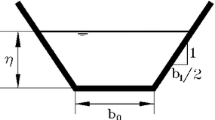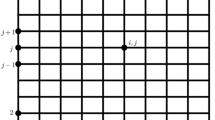Abstract
The theoretical behavior of a one-dimensional (1-D) open-channel flow is embedded in the Saint-Venant equation, which is derived from the Navier–Stokes equations. The flow motion is described by the momentum equations, in which the terms for the inertia, pressure, gravity, and friction loss are retained while all other terms are discarded. Although the problem is valid for most channel-flow scenarios, it is numerically challenging to solve because robust, accurate, and efficient algorithms are critical for models to field applications. The method of characteristics (MOC) is applied to solve the diagonalized Saint-Venant equations. Most importantly, the boundary conditions can be naturally implemented based on the wave directions. This is considered more closely related to realistic flow conditions and sufficiently flexible to handle mixed sub- and supercritical fluid flows in natural rivers. A computer model, WASH1DF, derived from the proposed numerical method, and which differs from other commercial software packages such as HEC-RAS and SOBEK, was developed. To test the accuracy of the proposed method, four benchmark problems were examined. Analytical solutions to these benchmark problems, covering a wide range of cases, were provided by MacDonald et al. (J. Hydrol. Eng. ASCE 123(11), 1041–1045, 1997). The simulations indicate that the proposed method provides accurate results for all benchmark cases, which are valid for all transient flow scenarios. Comparisons of WASH1DF with other commercially available software packages were also conducted under the same simulation conditions. The results indicate that our proposed model demonstrates high accuracy for all problems and achieves the highest simulation precision among all packages tested.
Similar content being viewed by others
References
Aràndiga, F., Velda, A.M.: Weighted ENO interpolation and applications. Commun. Nonlinear Sci. Numer. Simulat. 9, 187–195 (2004)
Baptista, A.M.: Solution of advection-dominated transport by Eulerian-Lagrangian methods using the backward methods of characteristics. Ph.D. dissertation, Department of Civil Engineering MIT (1987)
Bates, P., De Roo, A.P.J.: A simple raster-based model for flood inundation simulation. J. Hydrol. 236, 54–77 (2000)
Benkhaldoun, F., Elmahi, I., Seaid, M.: A new finite volume method for flux gradient and source-term balancing in shallow water equations. Comput. Meth. Appl. Mech. Engrg. 199(49–52), 3324–3335 (2010)
Bradford, S.F., Katopodes, N.D.: The antidissipative, non-monotone behavior of Petrov–Galerkin upwinding. Int. J. Numer. Meth. Fluids 33, 583–608 (2000)
Bryson, S., Levy, D.: Mapped WENO and weighted power ENO reconstructions in semi-discrete central schemes for Hamilton-Jacobi equations. Appl. Numer. Math. 56, 1211–1224 (2006)
Brunner, G.W.: HECRAS-river analysis system, hydraulic reference manual version 4.0, U.S. Army Corps of Engineers, Hydrologic Engineering Center, Davis, California (2008)
Cheng, J.R., Cheng, H.P., Yeh, G.T.: A Lagrangian-Eulerian method with adaptively local zooming and peak/valley capturing approach to solve two-dimensional advection–diffusion transport equations. Int. J. Numeri. Methods Eng. 39(6), 987–1016 (1996)
Cheng, J.R., Cheng, H.P., Yeh, G.T.: A Lagrangian-Eulerian method with adaptively local zooming and peak/valley capturing approach to solve three-dimensional advection–diffusion transport equations. Int. J. Numeri. Methods Eng. 41(4), 587–615 (1998)
Chow, V.T.: Open channel hydraulics. McGraw Hill, New York (1959)
Chow, V.T., Maidment, D.R., Mays, L.W.: Applied hydrology. McGraw-Hill, New York (1988)
Danish Hydraulic Institute. http://www.mikepoweredbydhi.com/products/mike-she (2016)
Deltares: SOBEK Suite. https://www.deltares.nl/en/software-solutions/ https://www.deltares.nl/en/software-solutions/ (2011)
Deng, X., Zhang, H.: Develo** high-order weighted compact nonlinear schemes. J. Comput. Phys. 165, 22–44 (2000)
Hirsch, C.h., Lacor, C., Deconinck, H.: Convection algorithms based on a diagonalization procedure multidimensional Euler equations. Proceedings of AIAA 8th Computational Fluid Dynamics Conference, AIAA Paper 87-1163, pp. 667–676 (1987)
Huthoff, F., Roos, P.C., Augustijn, D.C.M., Hulscher, S.J.: Interacting divided channel method for compound channel flow. J. Hydraul. Eng. 134(8), 1158–1165 (2008)
Jiang, L., Shan, H., Liu, C.: Weighted compact scheme for shock capturing. Int. J. Comput. Fluid Dyn. 15, 147–155 (2001)
Jiang, G.S., Shu, C.W.: Efficient implementation of weighted ENO schemes. J. Comput. Phys. 126(1), 202–228 (1996)
Knight, D.W.: Conveyance in 1D models. Annex of sco** study on reducing uncertainty in river flood conveyance. Rand&D Technical Report to DEFRA/Environment Agency, HR Wallingford Ltd., prepared by Evans, E.P., Pender, G., Samuels, P.G., Escarameia, M. Swindon, UK (2001)
Innovyze. http://www.innovyze.com/about/ (2016)
Lax, P.D., Wendroff, B.: Systems of conservation laws. Commun. Pure Appl. Math. 13, 217–237 (1960)
Lin, B., Wicks, J.M., Falconer, R.A., Adams, K.: Integrating 1D and 2D hydrodynamic models for flood simulation. In: Proceedings of the Institution of Civil Engineers—Water Management Incorporated, pp 19–25 (2006)
Leonard, B.P., Mokhtari, S.: Beyond first-order unwinding, theULTRA-SHARP alternative for non-oscillatory steady-state simulation of convection. Int. J. Numeri. Methods Eng. 30, 729–866 (1990)
MacCormack, R.W.: The Effect of viscosity in hypervelocity impact cratering. AIAA Paper, pp. 69–354 (1969)
MacDonald, I., Baines, M.J., Nichols, N.K., Samuels, P.G.: Analytic benchmark solution for open-channel flows. J. Hydrol. Eng. ASCE 123(11), 1041–1045 (1997)
Mattsson, K., Carpenter, M.H.: Stable and accurate interpolation operators for high-order multiblock finite difference methods. SIAM J. Sci. Comput. 32(4), 2298–2320 (2010)
Mattsson, L., Ham, F., Iaccarino, G.: Stable boundary treatment for the wave equation on second-order form. J. Sci. Comput. 41, 366–383 (2009)
Price, R.K., Samuels, P.G.: A computational hydraulic model for rivers. Proc. Inst. Civ. Engrs. 69(2), 87–96 (1980)
Rao, P.: Numerical modeling of open channel flows using a multiple grid ENO scheme. Appl. Math. Comput. 161, 599–610 (2005)
Samuels, P.G., Gary, M.P.: The FLUCOMP river model package—an engineers guide. Report No EX 999. HR Wallingford Ltd, UK (1982)
Shu, C.W., Osher, S.: Efficient implementation of essentially non-oscillatory shock-capturing schemes. J. Comput. Phys. 77(2), 439–471 (1988)
Singh, V.P.: Kinematic wave modeling in water resources—surface water hydrology. Wiley-Interscience, New York (1996)
Song, L., Zhou, J., Guo, J., Zou, Q., Liu, Y.: A robust well-balanced finite volume model for shallow water flows with wetting and drying over irregular terrain. Adv. Water Resour. 34(7), 915–932 (2011)
Suk, H., Yeh, G.T.: 3D, three-phase flow simulations using the Lagrangian-Eulerian approach with adaptively zooming and peak/valley capturing scheme (LEZOOMPC). J. Hydrol. Eng. ASCE 12(1), 14–32 (2007)
Suk, H., Yeh, G.T.: A multi-dimensional finite element particle tracking method for solving complex transient flow problems. J. Hydrol. Eng. ASCE 14(7), 759–766 (2009). https://doi.org/10.1061/(ASCE)HE.1943-5584.0000047
Svärd, M., Nordström, J.: Review of summation-by-parts schemes for initial-boundary-value problems. J. Comput. Phys. 268, 17–38 (2014)
Udaykumar, H.S., Tran, L., Belk, D.M., Vanden, K.J.: An Eulerian method for computation of multilateral impact with ENO shock-capturing and sharp interfaces. J. Comput. Phys. 186, 136–177 (2003)
Vater, S., Beisiegel, N., Behrens, J.: A limiter-based well-balanced discontinuous Galerkin method for shallow-water flows with wetting and drying: one-dimensional case. Adv. Water Resour. 85, 1–13 (2015)
Wang, S., Virta, K., Kreiss, G.: High order finite difference methods for the wave equation with non–conforming grid interfaces. J. Sci. Comput. 68, 1002–1028 (2016)
Williamson, D.L., Rasch, P.J.: Two-dimensional semi-Lagrangian transport with shape-preserving interpolation. Mon. Weather Rev. 117, 102–129 (1989)
**a, X., Liang, Q., Pastor, M., Zou, W., Zhuang, Y.F.: Balancing the source terms in a SPH model for solving the shallow water equations. Adv. Water Resour. 59, 25–38 (2013)
Yeh, G.T.: A Lagrangian-Eulerian method with zoomable hidden fine-mesh approach to solving advection–dispersion equations. Water Resour. Res. 26(6), 1133–1144 (1990)
Yeh, G.T., Chang, J.R., Cheng, H.P., Sung, C.H.: An adaptive local grid refinement based on the exact peak capturing and oscillation free scheme to solve transport equations. Int. J. Comput. Fluids 24(3), 293–332 (1995)
Yeh, G.T., Chang, J.R., Short, T.E.: An exact peak capturing and oscillation-free scheme to solve advection–dispersion transport equations. Water Resour. Res. 28(11), 2937–2951 (1992)
Yeh, G.T., Huang, G.B., Zhang, F., Cheng, H.P., Lin, H.C.: WASH123D: a numerical model of flow, thermal transport, and salinity, sediment, and water quality transport in WAterSHed systems of 1-D streamriver network, 2-D overland regime, and 3-D subsurface media. Technical Report Submitted To EPA, Department of Civil and Environmental Engineering. University of Central Florida, Orlando (2006)
Yeh, G.T., Shih, D.S., Cheng, J.R.C.: An integrated media, integrated processes watershed model. Comput. Fluids 45, 2–13 (2011)
Yen, B.C.: Open-channel flow equations revised. J. Eng. Mech. Div. ASCE 99(5), 979–1009 (1973)
Yen, B.C., Tsai, C.W.-S.: On noninertia wave versus diffusion wave in flood routing. J. Hydrol. 244, 97–104 (2001)
Zhang, F., Jiang, L., Yeh, G.T., Parker, J.C.: An adaptive local refinement and peak/valley capture algorithm to solve nonlinear transport problems with moving sharp-fronts. Transp. Porous Med. 72, 53–69 (2008)
Zienkiewicz, O.C., Codina, R.: general algorithm for compressible and incompressible flow. Part I: the split characteristic based scheme. Int. J. Numer. Methods Fluids 20(8–9), 869–885 (1995a)
Zienkiewicz, O.C., Morgan, K., Satya Sai, B.V.K., Codina, R., Vazquez, M.: A general algorithm for compressible and incompressible flow. Part II: tests on the explicit form. Int. J. Numer. Methods Fluids 20(8–9), 887–913 (1995b)
Author information
Authors and Affiliations
Corresponding author
Rights and permissions
About this article
Cite this article
Shih, DS., Yeh, GT. Using a characteristic-based particle tracking method to solve one-dimensional fully dynamic wave flow. Comput Geosci 22, 439–449 (2018). https://doi.org/10.1007/s10596-017-9703-7
Received:
Accepted:
Published:
Issue Date:
DOI: https://doi.org/10.1007/s10596-017-9703-7




